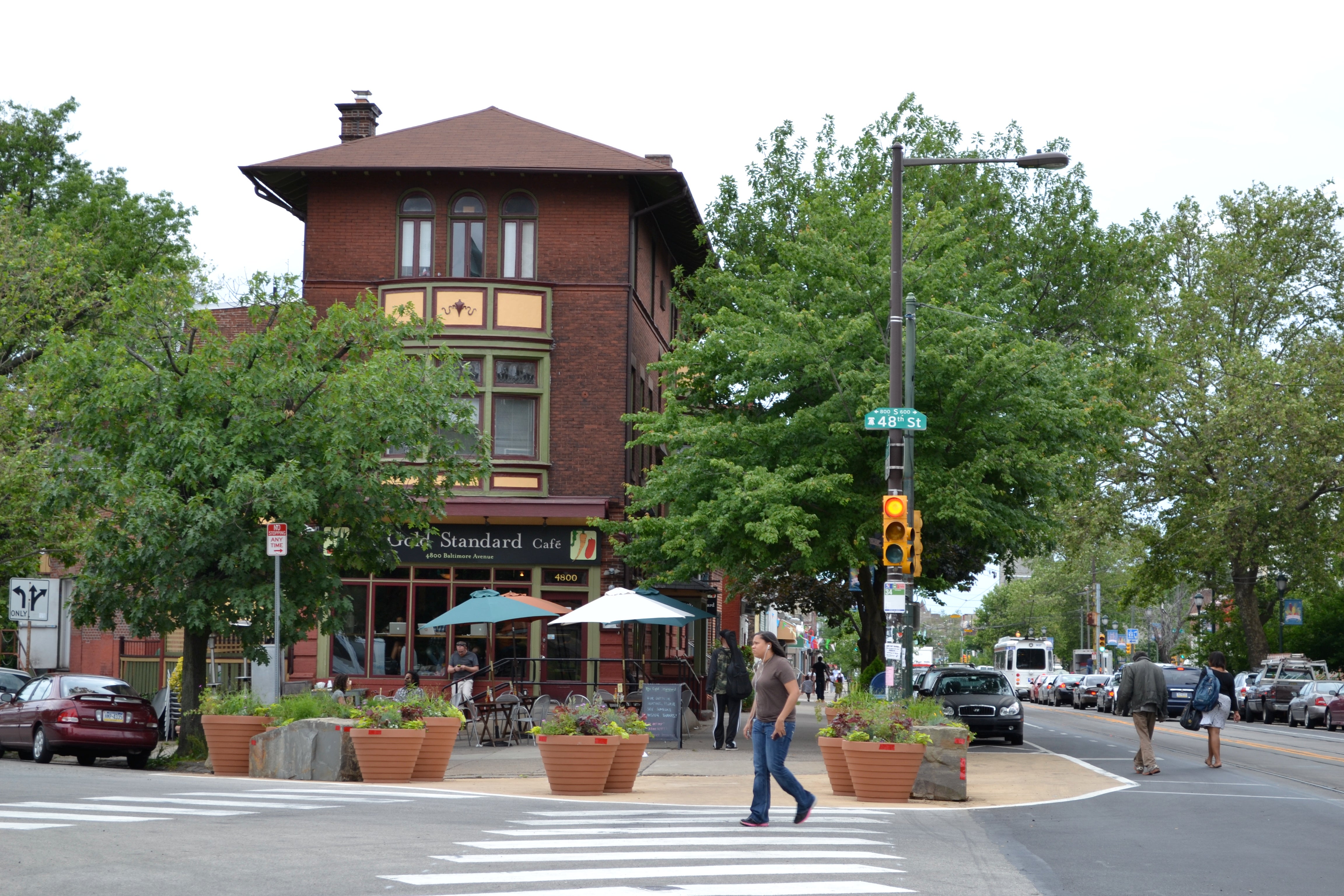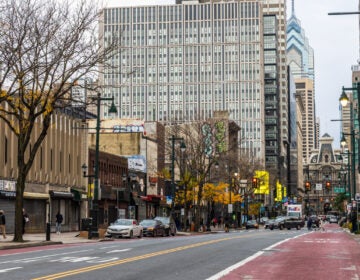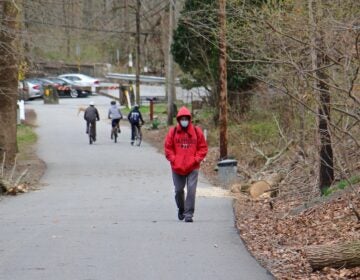Q&A: Mike Lydon on the state of ‘tactical urbanism’ and why Park(ing) Day still matters

Last Friday, Mike Lydon, the author of Tactical Urbanism and a principal at The Street Plans Collaborative came down to Philly from New York to present at Philadelphia’s Park(ing) Day after-party at the Center for Architecture. We caught up with him beforehand to discuss the continued relevance of Park(ing) Day, what’s new in tactical urbanism, and the new public space kit Street Plans is developing.
PlanPhilly: This week at the office we were talking about how Park(ing) Day feels like it’s become a good bit more corporate in recent years. There are more high design parklets from local architecture and design firms around, which are great, but it seems to be turning into more of a fun marketing opportunity than a statement about street use. Are you seeing that other places? What do you make of the direction Park(ing) Day has taken?
Mike Lydon: It’s definitely continued to evolve, and you can look at a number of cities that have done it for 5-10 years now, and they’re getting to the point where, as you just described, it’s more mainstream, or companies are using it as a billboard, so to speak.
I can understand that, and there’s some value to that in a different way, but it’s a little bit divorced from the original intent of the project. It’s really important to underscore in the conversation around Park(ing) Day that it ideally should be connected to achieving something long-term. Connect it to policies that need to change. Connect it to a problem on the street that can be communicated to regular passers-by.
Another positive trend I’m noticing is cities are not only legally allowing it to happen, but are embracing new policies or programs that allow for more of these activities to happen in the neighborhoods. It’s exciting that more people are recognizing the value inherently, and establishing frameworks that allow citizens not just to do Park(ing) Day on the third Friday of September, but regularly go out and do their own demonstration projects in the streets.
PP: Do you think there is still a utility to doing Park(ing) Day, now that parklets and pedestrian plazas have become more mainstream tools in many large US cities?
ML: There’s a real utility to it particularly if you can keep it tactical, and connect it to strategy. A parklet can be a way to educate people about a problem on the street, or provide some type of physical intervention that is responding to a real challenge.
I was reading an article today about the city of Hamilton, Ontario which is not unfamiliar with tactical urbanism, but has not really moved forward with policies or programs to enable it at the citizen level or the business level, and they’re using this Park(ing) Day as an opportunity, while parklets are on people’s minds, to unveil a new policy allowing for demonstration projects or interventions by citizen or business groups.
At the same time, when the cities start to offer support like that, or corporations start to get involved with this stuff, that’s a signal to folks on the advocacy side that it’s time to find whatever the next Park(ing) Day is for them, or begin to use Park(ing) Day as a platform to advocate for their issues. It still offers a good opportunity to draw attention to an issue.
PP: We’ve seen a few examples of that here, not specifically on Park(ing) Day, but where citizen groups will activate a public space regularly with the aim of one day closing it to cars. The Grays Ferry Triangle pedestrian plaza is one example of this. A group affiliated with the South of South Neighborhood Association (SOSNA) would continually shut down a small stretch of street near 23rd and South for different events, with the aim of one day closing it off completely. It took them almost nine years to actually do it, and it was only because Councilman Kenyatta Johnson finally intervened in the process. City Council has since lowered the required neighbor approval threshold from 100% support to 75%.
ML: That doesn’t surprise me. It’s great they stuck with it all that time. Sometimes it does take a decade for this stuff to move forward in a more permanent way. That being said, a lot of cities are now very intentionally looking for these opportunities. Chicago, San Francisco, New York—some places are now putting resources into ferreting out where these opportunities are, and finding the local stewards who will take those spaces and make them work for the neighborhood in a more permanent way.
PP: Which cities do you think have the maintenance issues figured out the best?
ML: That’s a great question and it’s well timed too because we are wrapping up a stewardship guide for emerging public spaces for the city of San Francisco. They’ve gotten to the point where they’re 7-8 years into doing a lot of these temporary demonstration projects that have been at the pilot level. Some of them are working really well, and some are not. So they asked us to look nationwide at other models for stewardship that could be incorporated in San Francisco.
Internally, they’ve done a pretty good job with connecting public spaces to benefit districts, business improvement districts who have the resources to do this. They tend to be most successful when there’s a day-to-day steward tasked with picking up the garbage, doing programming, etc.
And on the very low end of the spectrum they’ve found there can be very light-touch opportunities for neighborhood groups to get involved with activation of public space. At Friends of Duboce Park in San Francisco they have a tag sale every summer and they raise about $3,000. People bring out clothes and other things to sell, and then that money goes toward programming this park during the season when they show outdoor movies.
New York is very fortunate in that it has a whole non-profit now, the Neighborhood Plaza Partnership, that’s dedicated to the maintenance and stewardship of plazas, particularly in under-resourced neighborhoods. Chase put down close to a million dollars as a seed to get the plaza program to expand beyond Manhattan and Brooklyn, all over the five boroughs in neighborhoods who don’t have BIDs yet to maintain them.
PP: Are there any smaller or mid-sized cities you see coming up with interesting innovations in public space?
ML: Seattle has a program called Festival Streets which is fairly new, about two or three years old and not super tested yet, but they basically allow neighborhood groups to come to the city with requests to activate an alley or a block or a street all year long. Groups present a list of several events they want to do over the course of the year, and the city then allows them to take out just one permit for the whole year.
So it simplifies the whole process, the city knows exactly what to expect for the year, and in one of the cases they’ve actually gone back in to redesign the street infrastructure so that neighbors have outlets and other features they need to allow this to happen all the time.
I think Seattle’s really on to something with that. If it’s lower cost and easier to do, more things will happen, and you can create a positive cycle of activity.
PP: One thing Philly seems to do right in that vein is block parties. It’s really easy and cheap to get a block party permit here and that’s enabled a strong block party culture where we actually shut down more streets than any other US city. The permit is $25, and you only need 75% of the neighbors’ signatures to shut down your street on a weekend or holiday. Recently the city moved to make it even easier with online block party permits. Are you seeing any other promising developments on the process reform front?
ML: We were doing a bike and pedestrian master plan in Burlington, VT right now, and there’s such demand from the residents and the neighborhoods and non-profits to do demonstration projects in the streets, so as part of our scope, we added on a guide for the public to do demonstration projects.
So the city’s going to allow for this stuff very proactively, so residents can come together, check a few boxes, and do their project. We’re designing a lightweight approval system for that and the city’s open to it. This past weekend they were doing four different demonstration projects as a dry run of how it would work. I think Burlington is very much a city to watch when it comes to designing an approval process with a lot fewer barriers.
The whole point of tactical urbanism is to get people a working example that they can see physically in the neighborhood. Until you can get something like that, it’s so abstract and people just want to say no.
PP: What’s next on the cutting edge for tactical urbanism? What are you most excited about lately?
ML: Aside from Burlington, I’m also excited about the work we’re doing on maintenance in San Francisco. The dissemination of information around stewardship and maintenance is a really key piece of this. A lot more communities are getting very excited about doing demonstration projects like plazas and parklets, but they need the knowledge to assess who the players [who can approve them] are, who’s going to be the steward, where’s the funding coming from. And we want to help people think about that very clearly so when these projects get onto the street they can be a great success.
The other thing I’m excited about is the project we’ve proposed to the Knight Foundation, which is a materials guide to Tactical Urbanism. It’s focused on street safety projects, and we’re going to have 5-7 project types like how to do a mid-block crossing, a neighborhood traffic circle, a curb extension, and that kind of stuff.
But we’re looking at it as a phased approach, so what are the materials you need for a project that lasts only one day or one week? What do you need for a pilot project for one to six months, or an interim design that lasts 1-5 years? We’ll be looking at what NYC DOT uses, what Better Block uses, all along the spectrum of capacity. So whether you’re a neighborhood activist or a city Streets Department, we’re going to give you the kit of parts, tell you where to get the materials, how much it’ll cost, the pros and cons of using different kinds of materials, so that we’re daylighting the information that makes these projects a success. That will come out some time in 2016.
WHYY is your source for fact-based, in-depth journalism and information. As a nonprofit organization, we rely on financial support from readers like you. Please give today.






